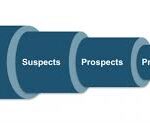The Sales Person’s Most Valuable Productivity Tool
Harry Koolen and I met as classmates at St. Lawrence University and have been partners specializing in business development consulting and training for more than twenty-years. We have found that if you ask a business if they have a pipeline, the answer is invariably “yes.” Then if you ask a sales leader if they conduct regular pipeline reviews, the answer is also “yes.”
Often, however, the milestones that comprise their pipeline came with the CRM system they purchased and the reviews consist of querying the sales team on how many deals they expect to close. As Harry explains in this article, both practices are seriously flawed. AJT
A well-designed pipeline is a sales person’s most valuable productivity tool. Indeed, the pipeline should be at the heart of the sales person’s productivity system and should guide the individual’s sales routines and activities.
A productive sales pipeline is built around a series of internal and external milestones in the team’s underlying sales process. We define a milestone as a stage in the sales process that (a) represents significant progress toward the achievement of a revenue goal, and (b) can be measured. Examples include: initial contact with a key decision maker; receiving permission to make a proposal; obtaining consensus on the terms of an offer from internal product / technical specialists; submitting the proposal; and negotiating the terms of a sale.
The pipeline tools embedded in most CRM systems are not well designed. They tend to take a least-common-denominator approach to the sales process, resulting in a design that is of little practical use to sales people. Moreover, because the sales team has not participated in the design of the pipeline, they often see it as a control device, imposed on them by IT or management, rather than a tool that can help them succeed.
The pipeline design process should begin by mapping the group’s sales process, step-by-step. Since not all steps in the sales process are milestones, it is important to avoid adding too much distracting “noise” to the pipeline by including lots of steps that can’t be measured. The key is to arrive at a design that balances simplicity and accuracy (both of which are key to ensuring that sales people actually use the pipeline).
In a recent online posting to the Harvard Business Review1, Scott Edinger makes the point that, “When it comes to sales metrics, a tremendous amount of time is spent reviewing information that leaders can do very little to influence”. This underscores the importance of accurately identifying the true milestones in the sales process. Each milestone should have a set of activities associated with it that help sales people better understand how to move leads through the pipeline and that can be focal points for coaching.
Experience tells us that there are two ways to grow sales revenues: (1) feed the pipeline with more qualified leads and (2) improve success rates at milestone stages throughout the entire sales process. This focus on the highest value sales activities is vital to improving both sales efficiency (concentrating on the right activities) and sales effectiveness (how well those activities are executed).
By way of example, here is an exercise that exemplary sales managers conduct with their teams. We call it the 3+3+3 Exercise, and it involves asking these questions to each sales person (usually at least once a month).
1. What are the next three new contacts that you plan to make? Focus on the earliest stages in the pipeline.
2. What are the next three proposals you plan to submit to clients and / or prospects? Focus on the middle stages of the pipeline.
3. What are the next three deals you expect to close? Focus on the late stages of the pipeline.
The answers to these questions lead to conversations about what each team member is actually doing to achieve these sales milestones. Harry Koolen
1https://hbr.org/2021/07/are-you-paying-attention-to-the-right-sales-metrics
Next: Pipeline Productivity Routines


Comments
The Sales Person’s Most Valuable Productivity Tool — No Comments
HTML tags allowed in your comment: <a href="" title=""> <abbr title=""> <acronym title=""> <b> <blockquote cite=""> <cite> <code> <del datetime=""> <em> <i> <q cite=""> <s> <strike> <strong>